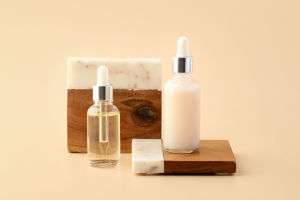In modern skincare, makeup removers and cotton pads have become increasingly popular as essential cleansing products.
Whether you are a makeup enthusiast or someone who follows a daily skincare routine, understanding the characteristics, usage methods, and selection tips for these products can help achieve both cleansing and skincare goals.
Makeup remover is a water-based cleansing product primarily used to remove makeup and impurities from the face. There are various types of makeup removers available on the market, mainly categorized as follows:
1. Water-based Makeup Remover: This type of product mainly consists of water and is usually quite gentle, making it suitable for dry and sensitive skin. They are characterized by their refreshing feel and non-greasy texture, effectively removing light makeup.
2. Oil-water Separation Makeup Remover: This type of remover typically has two layers that must be shaken before use. Oil-water separation makeup removers can effectively dissolve waterproof makeup, making them suitable for those needing to remove heavy makeup. They usually offer deep cleansing without leaving behind makeup residue.
3. Foaming Makeup Remover: This type of product has a lightweight texture and generates a rich foam during use, which can penetrate deep into the pores to cleanse facial impurities. It is suitable for oily and combination skin, but it may be somewhat irritating for dry skin.
Cotton pads are tools used in conjunction with makeup remover, usually made from cotton or other materials, and are soft enough to effectively absorb makeup and impurities. Choosing the right cotton pads is crucial for effective makeup removal. Here are a few aspects to consider when selecting cotton pads:
1. Material: There are various materials for cotton pads available on the market, including pure cotton and synthetic fibers. Pure cotton pads are soft and have good skin compatibility, making them suitable for sensitive skin, while synthetic pads are more durable but may cause irritation for sensitive skin.
2. Thickness: Cotton pads of moderate thickness can better absorb makeup remover and enhance cleansing effectiveness. However, overly thick cotton pads may lead to waste, so it’s essential to choose products with the right thickness.
3. Surface Texture: Some cotton pads have delicate textures on their surface, which can enhance their ability to absorb makeup and improve cleansing effectiveness. Consider the texture design when choosing.
Proper makeup removal steps are vital for thoroughly cleansing the skin. Here are the recommended steps for effective makeup removal:
1. Preparation: Before removing makeup, shake the makeup remover well to ensure the oil and water are fully mixed. Prepare the cotton pads and pour an appropriate amount of makeup remover onto the pads.
2. Eye Makeup Removal: Gently place the moistened cotton pad on the eye area and let it sit for a few seconds to allow the remover to penetrate the makeup. Then, gently swipe downwards to thoroughly clean the eye makeup.
3. Facial Makeup Removal: Use a new cotton pad and gently wipe the face in an inward-to-outward direction, paying particular attention to areas where makeup tends to accumulate, such as the forehead, nose, and chin. Replace the cotton pad as needed to ensure thorough cleansing.
4. Subsequent Cleansing: After completing makeup removal, it is advisable to use a facial cleanser for a second cleansing to ensure the skin is entirely clean. This step helps remove any residual makeup remover and keeps the skin fresh.
Makeup removers and cotton pads are indispensable cleansing tools in the skincare process, playing a crucial role in removing makeup and cleansing the skin. Understanding the different types of makeup removers, choosing the right cotton pads, and mastering the correct makeup removal steps can help us effectively eliminate facial impurities and makeup, providing better care for the skin.


